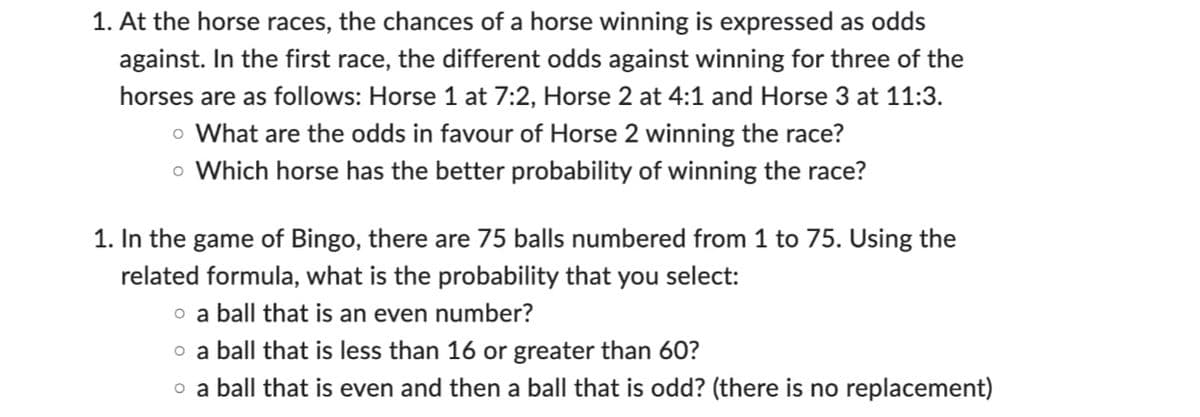1. At the horse races, the chances of a horse winning is expressed as odds against. In the first race, the different odds against winning for three of the horses are as follows: Horse 1 at 7:2, Horse 2 at 4:1 and Horse 3 at 11:3. o What are the odds in favour of Horse 2 winning the race? o Which horse has the better probability of winning the race? 1. In the game of Bingo, there are 75 balls numbered from 1 to 75. Using the related formula, what is the probability that you select: o a ball that is an even number? o a ball that is less than 16 or greater than 60? o a ball that is even and then a ball that is odd? (there is no replacement)
1. At the horse races, the chances of a horse winning is expressed as odds against. In the first race, the different odds against winning for three of the horses are as follows: Horse 1 at 7:2, Horse 2 at 4:1 and Horse 3 at 11:3. o What are the odds in favour of Horse 2 winning the race? o Which horse has the better probability of winning the race? 1. In the game of Bingo, there are 75 balls numbered from 1 to 75. Using the related formula, what is the probability that you select: o a ball that is an even number? o a ball that is less than 16 or greater than 60? o a ball that is even and then a ball that is odd? (there is no replacement)
Holt Mcdougal Larson Pre-algebra: Student Edition 2012
1st Edition
ISBN:9780547587776
Author:HOLT MCDOUGAL
Publisher:HOLT MCDOUGAL
Chapter11: Data Analysis And Probability
Section11.8: Probabilities Of Disjoint And Overlapping Events
Problem 2C
Related questions
Question

Transcribed Image Text:1. At the horse races, the chances of a horse winning is expressed as odds
against. In the first race, the different odds against winning for three of the
horses are as follows: Horse 1 at 7:2, Horse 2 at 4:1 and Horse 3 at 11:3.
o What are the odds in favour of Horse 2 winning the race?
o Which horse has the better probability of winning the race?
1. In the game of Bingo, there are 75 balls numbered from 1 to 75. Using the
related formula, what is the probability that you select:
o a ball that is an even number?
o a ball that is less than 16 or greater than 60?
o a ball that is even and then a ball that is odd? (there is no replacement)
Expert Solution
This question has been solved!
Explore an expertly crafted, step-by-step solution for a thorough understanding of key concepts.
This is a popular solution!
Trending now
This is a popular solution!
Step by step
Solved in 3 steps with 3 images

Recommended textbooks for you

Holt Mcdougal Larson Pre-algebra: Student Edition…
Algebra
ISBN:
9780547587776
Author:
HOLT MCDOUGAL
Publisher:
HOLT MCDOUGAL

Holt Mcdougal Larson Pre-algebra: Student Edition…
Algebra
ISBN:
9780547587776
Author:
HOLT MCDOUGAL
Publisher:
HOLT MCDOUGAL